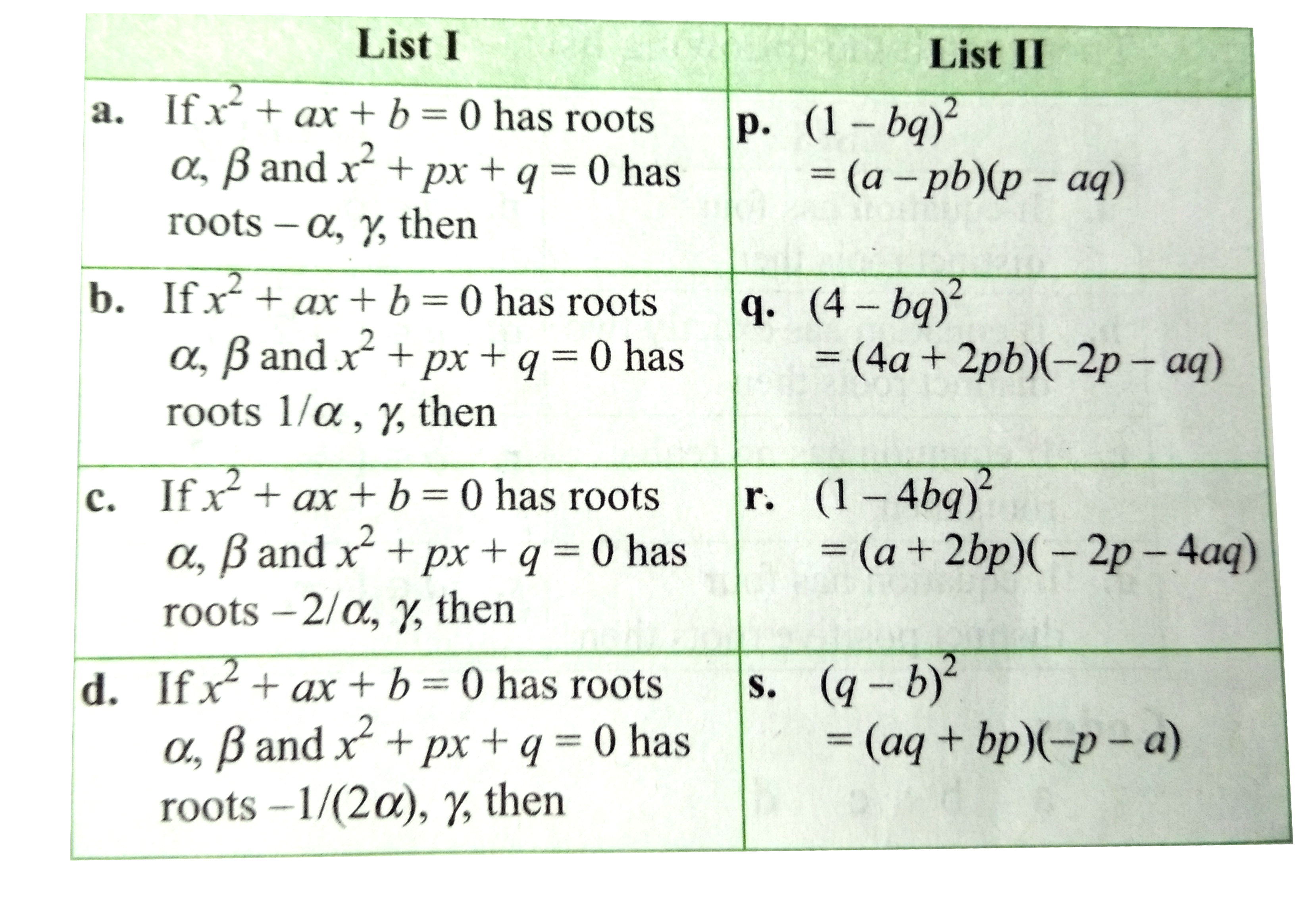Match the following lists:
 Solution in Bengali
Solution in Bengali
The correct Answer is:a→s;b→p;c→q;d→r
a→s,b→p,c→q,d→r
(a) x2ax+b=0 has root lapha. Hence.
α2+aα+b=0 (1)
x2+px+q=0 has root −α. Hence,
α2−pα+q= (2)
Eliminating α from (1) and (2), we get
(q−b)2=(aq+bp)(−p−a)
or (q−b)2=−(aq+pb)(p+a)
(b) x2ax+b=0 has root α. Hence,
α2+aα+b=0 (1)
x2+px+q=0 has root 1/α. Hence,
qα2+pα+1=0 (2)
Eliminating α from (1) and (2), we get
(1−bq)2=(a−pb)(p−aq)
(c) x2+ax+b=0 has roots, α,β. Hence,
α2+aα+b=0 (1)
x2+px+q=0 has roots −2/α,γ. Hence,
qα2−2pα+4=0 (2)
Eliminating α from (1) and (2), we et
(4−bq)2=(4a+2pb)(−2p−aq)
(d) x2+ax+b=0 has roots α,β. Hence,
α2+aα+b=0 (1)
x2+px+q=0 has roots −1/2α,γ. Hence,
4qα2−2pα+1=0 (2)
Elimintaing α from (1) and (2), we get
(1−4bq)2=(a+2bp)(−2p−4aq)
Topper's Solved these Questions
- BOOK - CENGAGE PUBLICATIONCHAPTER - THEORY OF EQUATIONSEXERCISE - NUMERICAL VALUE TYPE43videos
THEORY OF EQUATIONS
- BOOK - CENGAGE PUBLICATIONCHAPTER - THEORY OF EQUATIONSEXERCISE - Archives JEE MAIN (single correct Answer Type )7videos
THEORY OF EQUATIONS
- BOOK - CENGAGE PUBLICATIONCHAPTER - THEORY OF EQUATIONSEXERCISE - Linked Comprechension Type37videos
THEORY OF EQUATIONS
- BOOK - CENGAGE PUBLICATIONCHAPTER - STRAIGHT LINESEXERCISE - ARCHIVES (NUMERICAL VALUE TYPE)1videos
STRAIGHT LINES
- BOOK - CENGAGE PUBLICATIONCHAPTER - THREE DIMENSIONAL GEOMETRYEXERCISE - All Questions291videos
THREE DIMENSIONAL GEOMETRY
Similar Questions
If x=2+22/3+21/3 , then the value of x3−6x2+6x is
View SolutionIf the roots of the equation bx2+cx+a=0 be imaginary, then for all real values of x, the expression 3b2x2+6bcx+2c2 is (1) greater than 4ab (2) less than 4ab (3) greater than −4ab (4) less than 4ab
06:07View SolutionConsider an unknow polynomial which divided by (x−3) and (x−4) leaves remainder 2 and 1, respectively. Let R(x) be the remainder when this polynomial is divided by (x−3)(x−4).
If equations R(x)=x2+ax+1 has two distint real roots, then exhaustive values of a are.02:11View SolutionFor a point P in the plane, let d1(P)andd2(P) be the distances of the point P from the lines x−y=0andx+y=0 respectively. The area of the region R consisting of all points P lying in the first quadrant of the plane and satisfying 2≤d1(P)+d2(P)≤4, is
01:31View SolutionFind the angle between the line whose direction cosines are given by l+m+n=0andl2+m2−n2=0.
02:45View SolutionMatch the following lists:
 02:17View Solution
02:17View SolutionWhich of the following are correct chain isomers of butane ? (i)
05:41View SolutionDetermine the point of symmetry of a regular hexagon.
02:10View SolutionDtermine the images of the following figure about the given line :
02:17View SolutionMatch the following Column A to Column B
 02:10View Solution
02:10View SolutionMatch the following Column A to Column B
 03:12View Solution
03:12View SolutionMatch the following Column A to Column B
 08:58View Solution
08:58View SolutionThe inequation represented by the graph given below is :
04:00View SolutionThe inequation that best describes the graph given below is _________
05:46View SolutionThe inequation that best describes the following graph is _________
06:52View SolutionMatch the followings (column I with column II)
ltimg src="https://d10lpgp6xz60nq.cloudfront.net/physics_images/NCERT_BIO_XI_C03_E01_011_Q01.png" width="80%"gt06:14View Solution

